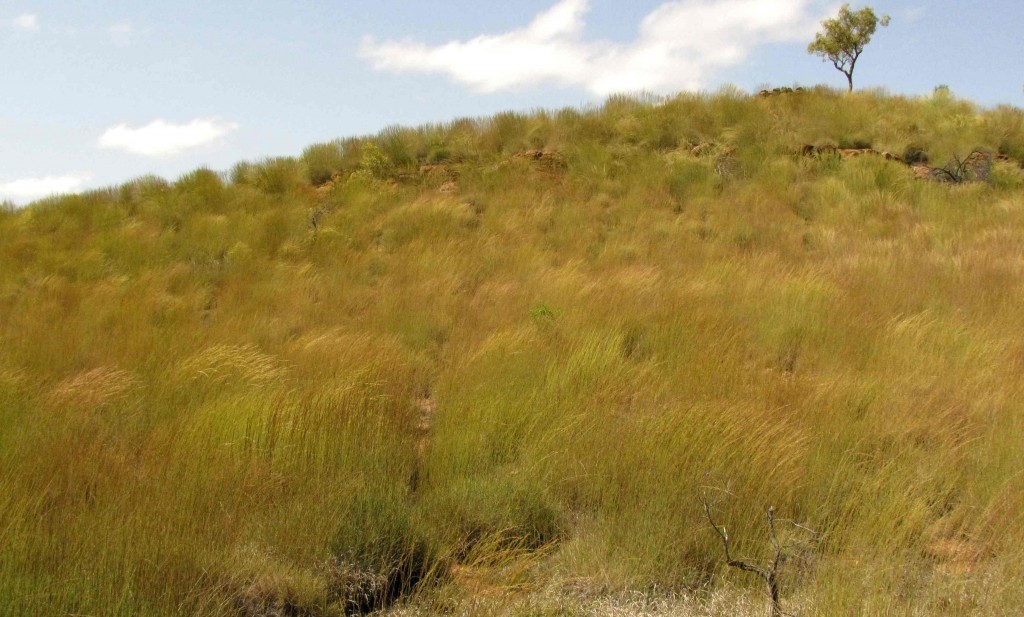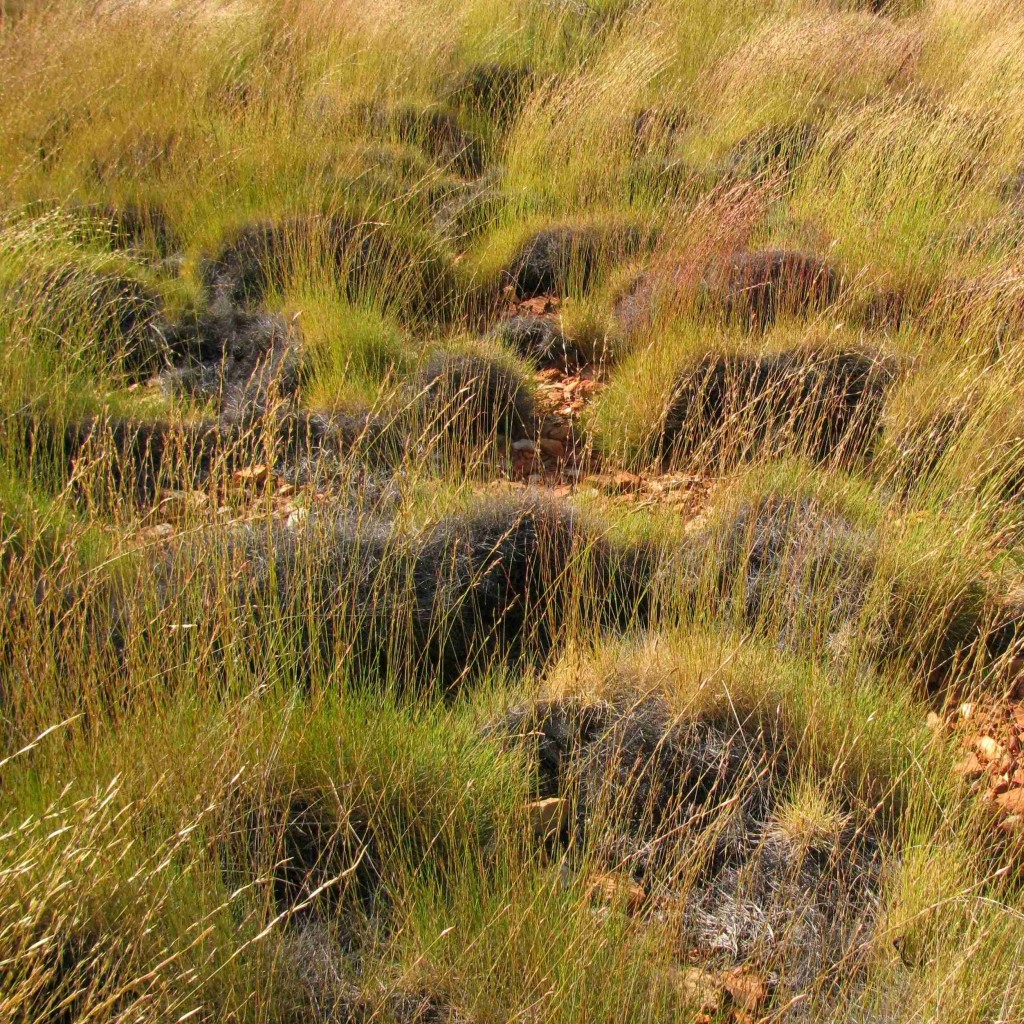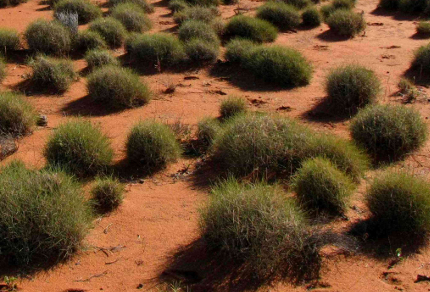
Lush Spinifex Grassland south of Alice Springs, Northern Territory (© Vilis Nams)
In February, I listened to an ABC radio documentary about the Simpson Desert, in which Dr. Chris Dickman of Sydney University discussed the pivotal role spinifex – a spiky, slow-growing, clump-forming grass – plays in that desert ecosystem.1 ‘Spinifex’ seemed such a magic word, completely captivating me as my imagination conjured up images combining the golden spinning prowess of the miller’s daughter in the Rumpelstiltskin fairytale and the boldness of the indominatable Gauls in the Asterix comics. In reality, the word combines two Latin roots – spīna, meaning ‘spine’ or ‘thorn’, and -fex, meaning ‘maker,’ referring to the spiny seeds the grass produces.2
In the world of Australian grasses, ‘spinifex’ has two connotations. It is both the genus name – Spinifex – of a group of perennial, sand-binding grasses that grow along Australian coasts, and the common name for perennial grasses of the genus Triodia, which occur across vast expanses of Australia’s arid interior and on rocky sites near the coast.3 The spinifex of the Simpson Desert to which Dr. Dickman referred, as well as the spinifex Vilis and I observed in the Alice Springs area and that Vilis and Janis observed in Western Australia, belong to the second of these grass connotations. Arid, hummocky grasslands comprised of Triodia spinifex cover more than 20% of the land surface of Australia.3 Thus, spinifex grasslands are one of this continent’s most widespread and significant vegetation types.

Spinifex Grassland, Yakabindi Station, Western Australia (© Vilis Nams)

Eroding Clumps of Spinifext, West MacDonnell National Park, Northern Territory (© Vilis Nams)
Triodia spinifex grasses are sometimes called porcupine grasses3 because of their stiff, pointed leaves. These needle-like leaves are an effective means of protection, as I discovered upon being jabbed painfully through my pant legs a multitude of times when Vilis and I wandered off the trail en route to Ormiston Pound, necessitating a little bushwhacking in our bushwalking. Clumps of spinifex may grow to a couple of metres across and a metre high3, so can present formidable barriers to comfortable movement. Always, the newest growth is on the outer surface of the clumps, with stems and dead leaves accumulating in the centre.3 Very old clumps disintegrate from the inside out,3 exposing grey detritus, which can be seen in the photograph to the left.
Spinifex grasslands are fire-adapted plant communities.3 Many Triodia species have resin-loaded leaves that fuel extremely hot fires.3 The heat of a passing fire causes seeds dormant in the soil to germinate.3 Following a fire, spinifex initiates new growth from not only seeds, but also from resprouts at the base of burned hummocks.3

Spinifex Pigeon beside Spinifex, Ormiston Gorge, West MacDonnell National Park, Northern Territory (© Vilis Nams)
Although spinifex communities are widespread over Australia’s arid and rocky regions, they provide poor grazing for livestock.4 On the other hand, spinifex vegetation is inhabited by rich communities of native vertebrate and invertebrate animal life. In the Alice Springs area, Vilis and I observed spinifex pigeons and zebra finches feeding on spinifex seeds, a little button-quail hiding at the base of a spinifex clump, and locusts leaping out of clumps of spinifex at our approach. In the ABC radio documentary I referred to at the start of this post, Dr. Dickman explained how termites feed on spinifex in the Simpson Desert and are, in turn, eaten by a web of predators that includes insectivorous marsupials and several species of specialist legless lizards.1 Other animals also rely on the spinifex for food, or for hunting opportunities or shelter, creating one of the richest assemblages of arid fauna on earth.1 So, perhaps spinifex, which undoubtedly shares some of the feistiness of those indominatable Gauls, does weave a little golden magic, in terms of biodiversity.

Little Button-quail Hiding under Spinifex on Rocky Crest above Ormiston Pound, West MacDonnell National Park, Northern Territory (© Vilis Nams)
References:
1. ABC Radio National, The Science Show. Ecology of the Simpson Desert (Karen Snowdon). Saturday, February 20, 2010, 12:34 PM. © 2010 ABC. Accessed 22-Feb-2010. http://abcscience.com.au/rn/scienceshow/stories/2010/2814565.htm
2. Your Definition.com. Spinifex. © 2010. Accessed 6-Oct-2010. http://www.yourdictionary.com/spinifex
3. Hummock Grasslands in Australia. Accessed 8-Oct-2010. http://www.bio.mq.edu.au/dept/centres/comparative/rice/spinifex.htm
4. Queensland Murray Darling Committee Inc. Fact Sheet – Biodiversity: Spinifex grasslands. 2006. Accessed 8-Oct-2010. http://www.qmdc.org.au/publications/download/7/fact-sheets-case-studies/spinifex-grasslands.pdf


